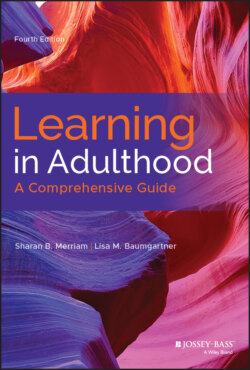Читать книгу Learning in Adulthood - Sharan B. Merriam - Страница 13
Chapter 1 The Social Context of Adult Learning
ОглавлениеLearning, even self-directed learning, rarely occurs “in splendid isolation from the world in which the learner lives; … it is intimately related to that world and affected by it” (Jarvis, 2012, p. 11). What one wants to learn, what is offered, and the ways in which one learns are determined to a large extent by the nature of the society at any time. Contrast the young male apprentice of colonial times learning to be a blacksmith with today's middle-aged woman learning a new smartphone app, or the preparation needed to become a medical doctor at the turn of the twentieth century—less than a high school diploma—with today's long and specialized training.
It can also be argued that the nature of society at any point in time determines the relative emphasis placed on adult learning. In preindustrial societies, the rate of change was such that what a person needed to know to function as an adult could be learned in childhood. In societies hurrying to catch up, however, and in our own society with its accelerated rate of change, the urgency of dealing with social realities is felt by adults. In this global, increasingly technologically interconnected world, “the context for adult learning is growing more complex” (Nicolaides & Marsick, 2016, p. 9). The challenge for learners and adult educators is to understand the learning context whether it be “simple, complicated, complex [or] chaotic” and to adapt our learning and teaching (p. 10). Further, social issues such as immigration and climate change and individual concerns such as those related to health or family or finances often result in individuals attending courses or learning informally about these issues.
Although adult education is responsive to the context in which it takes place, it affects that same context. Take, for example, enormous changes in our society brought on by advances in technology. Advances in telemedicine mean doctors can diagnose patients who live at a distance using increasingly sophisticated web-based communication and patients can use smartphone apps to monitor their health. Auto mechanics must now be trained to diagnose engine problems using computers; auto manufacturers tout self-driving cars; a smartphone can be turned into a 3D printer; misplaced items such as keys, wallets, and backpacks can be located via smartphone. Adult education has responded to these technological advances by offering courses to learn this technology so that we can better function in our digital environment.
Although the preceding examples of learning are particularly contemporary, historically there has always been an interlocking of adult learning needs with the social context in which they occur. The skills needed in colonial America reflected the agrarian context; further, since early settlers were fleeing religious persecution in Europe, there was a moral and religious imperative in learning to read so that one could study the Bible. After the Revolutionary War, the newly independent nation needed leaders and informed citizens to build the democratic society. In this new world, civic education, which included learning about philosophy, science, and politics, eclipsed religious education and became paramount in the education of adults.
With the Industrial Revolution of the late nineteenth and early twentieth centuries, industry-based skills training became a necessity. Also, because of the massive influx of immigrants to the United States at this time, “Americanization” and citizenship programs became a prominent form of adult education. It was felt that these immigrants needed to learn the ways of their adopted country so that they would “melt” into society. Interestingly, immigrants themselves organized their own schools to maintain their culture, but these were largely invisible to society at large.
Although a major thrust of adult education at any particular time reflects the sociohistorical context, varied purposes and learning interests coexist. We might argue that technology is a major thrust of learning today, but there is still job training, literacy, civic education, liberal (such as Great Books clubs) and leisure learning, along with community-based social-action initiatives. As Stubblefield and Keane (1994, p. 312) observed from their survey of adult education from colonial times until the present, regardless of the historical era, “Americans learned because there was knowledge to master, technology to adapt, and life's uncertainties to be resolved.”
Thus, to a large extent, the learning that goes on in adulthood can be understood through an examination of the social context in which it occurs. How is learning in adulthood shaped by the society in which it takes place? How does the sociocultural context determine what is learned and by whom?
This chapter explores three conditions characteristic of the current sociocultural context that are shaping the learning needs of adults in today's world: changing demographics, the global economy, and information and technology. Although we present each of these separately at first, these three factors are very much interrelated, and thus their convergence and subsequent impact on learning in adulthood are discussed in the final section of this chapter.
